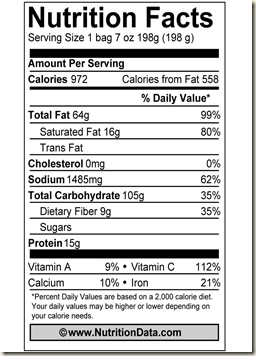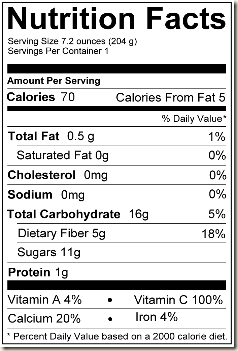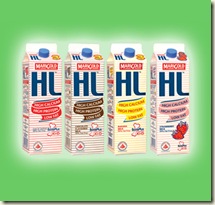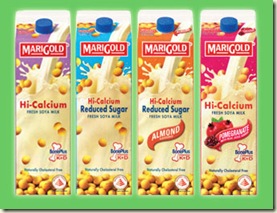When you buy foods in grocery store, you will see but may not pay attention to these food labels. Almost all prepackaged foods have their “Nutrition Facts” label attached. However, what does it really mean and how can you use it?
Let’s look at these two typical nutrition facts: 

1. Serving Size: The amount of the food that all the nutrients information based on. For example, the second nutrition facts has a serving size of 204g per serving. If you consume 408g or 2 servings, everything on the label has to time two (calories become 140, total fat 1.0g etc.).
2. %Daily Value: Actual number of a nutrient contained in the food can be confusing, so %Daily Value (%DV) is used for easier comparison of similar products. By looking at %DV you know if this food product contain a little or a lot of specific nutrient. One serving of each food product above can provide sufficient Vitamin C for the rest of the day. You can add up the %DV of different products and know whether you have obtained sufficient amount of specific nutrients in a day.
3. A few things on the list that you should try not to exceed 100% DV:
- Total fat
- Saturated fat
- Trans fat
- Sodium
Overconsumption of these nutrients has a higher risk to develop cardiovascular diseases, hypertension and coronary heart diseases. While our body still need fat and sodium to function properly, saturated fat and trans fat should be avoided as possible as you can.
4. Total carbohydrate (dietary fiber and sugars) and protein information can be used to count calorie intake especially for muscle builder and diabetes patient.
5. Vitamins and minerals listed after protein vary on different food products. You should consume sufficient amount of these nutrients too.
6. List of ingredients is not shown here but can always be found below or beside Nutrition Facts. It provides all the ingredients used for a food and are listed by weight, from the most to the least. It can be important since it is a source of allergy information and a source of certain nutrient information.
So, how can these information be useful?
- to help you compare similar foods easily
If you like to choose from two or more similar food products that has the same price, look at the nutrient facts so that you are able to see which one is healthier.
- to help you choose the foods that meet your requirement
If you like to gain weight, lose weight or build your muscle, these information can help you in counting calorie and make a more suitable food choice.
- to help you look for a food that has more or less of a specific nutrient
If you are diagnosed of specific nutrients deficiency or overdose, or if you are concerned of specific nutrient intake, you can use these information to make your food choice.
Try to take a few seconds to read the nutrition facts next time when you do grocery so that you will have a healthier diet with the same amount of money that you have been spending on foods.
Monday, August 9, 2010
Food Label: Information for you to make healthy choice
Posted by Duo For Zheng Hao at 3:32 PM Labels: Healthy Tips 0 commentsThursday, July 15, 2010
Lactose intolerance: how to deal with it?
Posted by Duo For Zheng Hao at 7:33 PM Labels: Healthy Tips 0 commentsDoes your stomach feel uneasy after you have milk? Is it one of the main reasons that cause you to avoid drinking milk? In fact, this problem, which is called “lactose intolerance”, is very common among the world populations.
What is lactose intolerance?
Every food we consume need to be broken down into simpler form before they can be absorbed and utilized in our body. Lactose, a complex form of sugar found mostly in dairy products, has to be broken down by lactase (one of the digestive enzymes) into glucose and galactose. If our body can’t produce enough lactase, these lactose will be transferred into colon undigested and enteric bacteria will undergo lactose fermentation that causes abdominal symptoms (eg. flaturence, diarrhea, nausea, and stomach cramps).
What is the consequence?
People tends to withdraw from drinking milk because of the uncomfortable experience. However, milk is an excellent source of some key nutrients including calcium, protein, vitamin D and vitamin A. Inadequate calcium and vitamin D intake can affect your bone health and may develop osteoporosis in later stage of life.


Different kind of lactose-free or alternative products found on the market
How can you deal with it?
1. Consume milk together with other non-lactose containing foods.
2. Drink a smaller portion of milk and add it up slowly to determine your tolerance threshold.
3. Choose alternative dairy products such as yogurt, soy milk, rice milk and cheese.
4. Choose lactose-reduced or lactose-free milk.
5. Take lactase enzyme supplement before you consume lactose containing products.
6. Consume calcium-fortified fruit juice
7. Consume non-dairy products that have rich calcium content (eg. rhubarb, sardines, salmon and spinach)
Finally…
Lactose intolerance is not considered as a disease. It is a reduced or absent activity of lactase in your body to metabolize lactose. If you can follow just a few suggestions given above, you might be able to avoid the occurrence of the problem. So begin with a small glass of milk and enjoy the benefit it provides starting from today!
Nutrition Duo is opened!
Posted by Duo For Zheng Hao at 12:16 AM 0 commentsWelcome to Nutrition Duo!
As a nutrition major graduate, I have been thinking to do something related to my major which can be beneficial to all my friends. The idea of using a blog site came out one year ago soon after I graduated. However, I spent quite a while in order to figure out the direction and focus of the site, so it had not been ready until now and somehow I am relieved that I can finally show it to all of you.
This blog site will be focused on simple yet useful nutrition information, nutrition facts and myths, healthy tips and Q&A session. Based on the feedbacks, the focus of the content might be altered as well. However, I hope that this site will provide anything that you like to know about your diet and ultimately what you learn here can be applied directly into your daily life.
As a nutrition educator, validity, credibility and reliability is what I am asking for every article which I'm going to write. The mission statement of this blog site is to provide accurate and reliable information to its readers.
If you are doubtful about the information on this site, please feel free to contact me via the email provided at the side bar and I’ll be more than willing to answer your question. Any nutrition related question and feedback are welcomed too.
Once again, thank you for coming and enjoy your stay!
